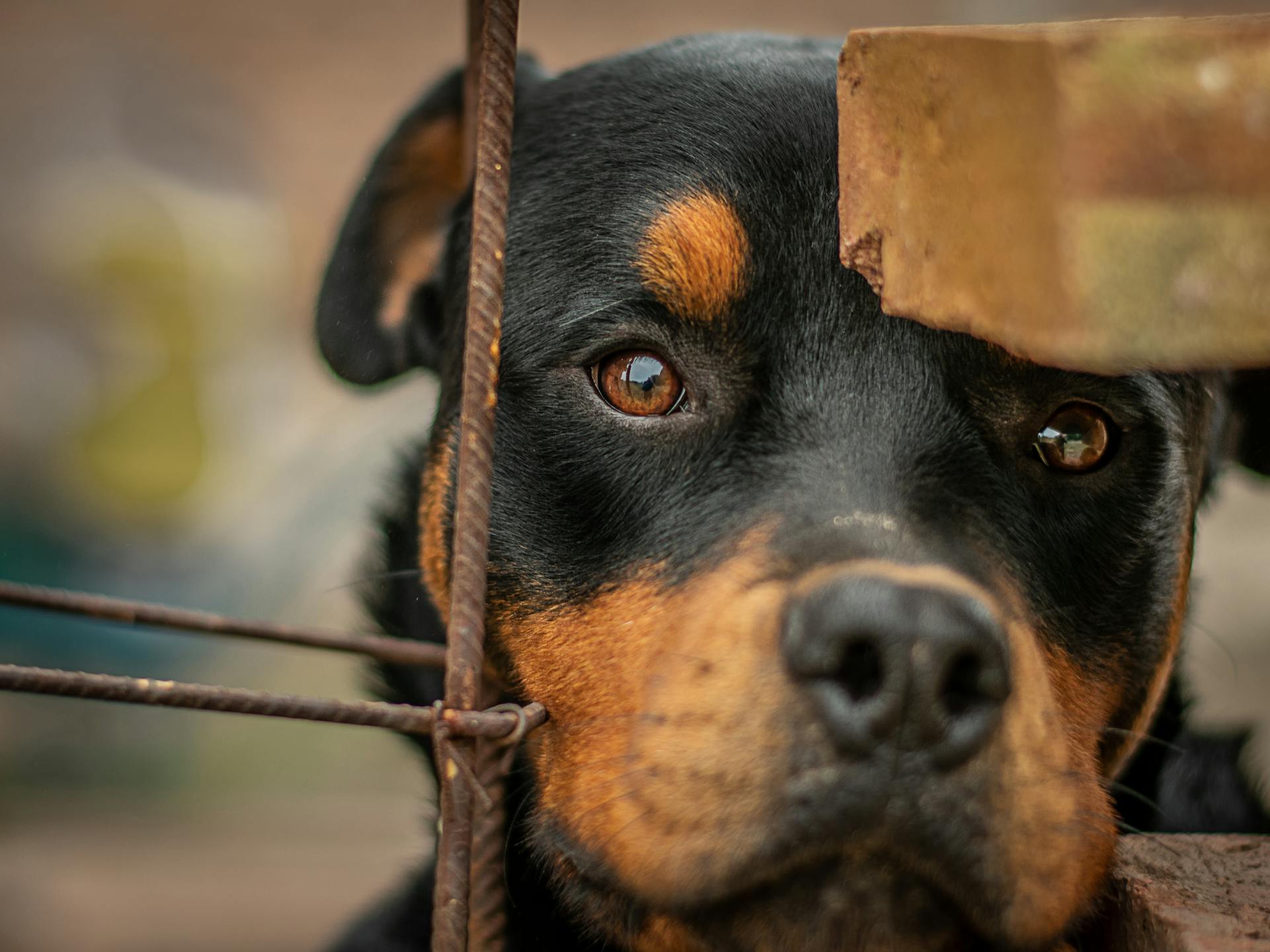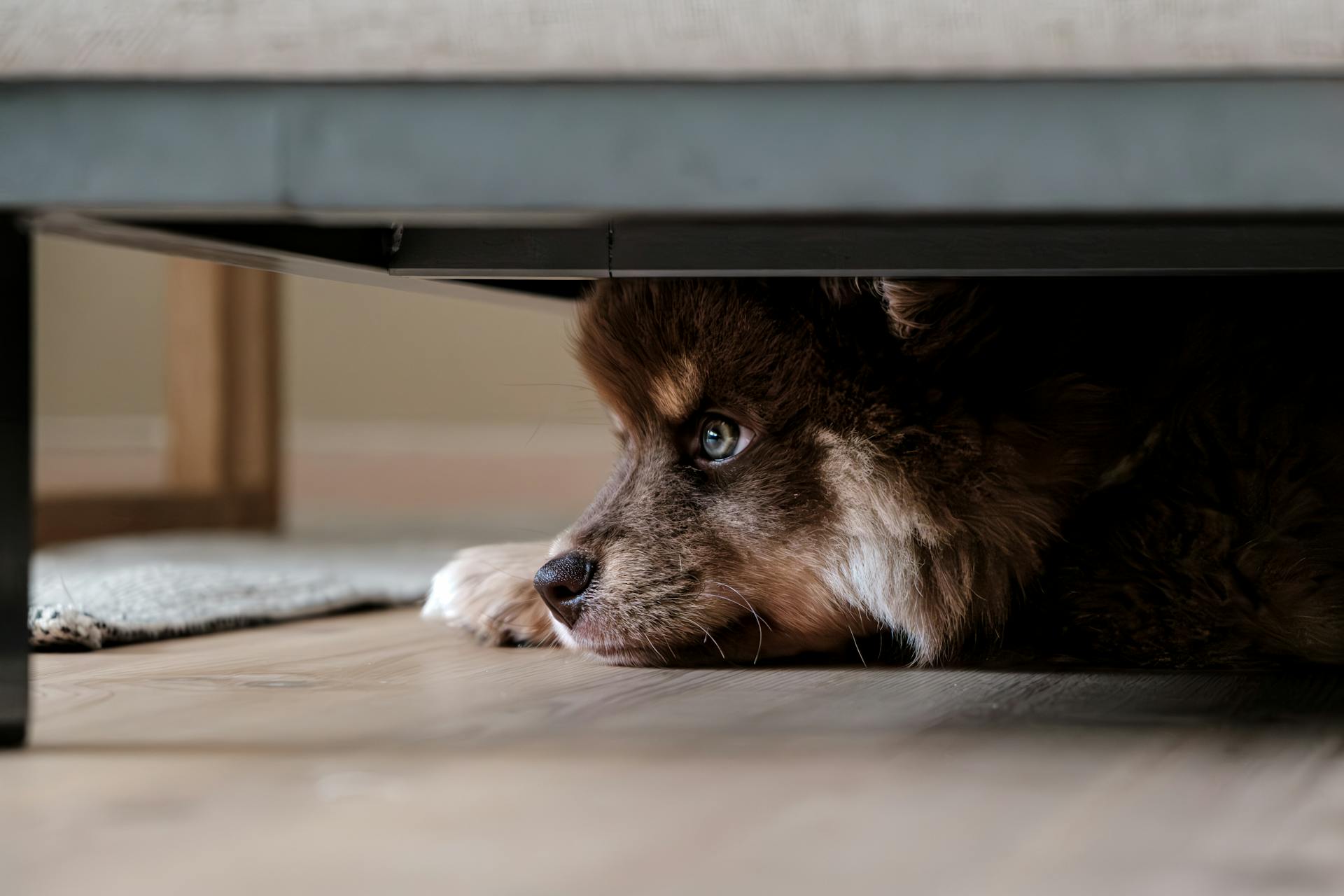
Rottweilers are prone to hip dysplasia, a genetic condition that affects the hip joint. This is due to their large size and rapid growth rate, which can put excessive stress on the joint.
Hip dysplasia can cause pain and arthritis in Rottweilers, leading to a decreased quality of life. Rottweilers with hip dysplasia may experience difficulty walking or standing.
The condition can be detected through a hip evaluation, which is a series of tests that assess the hip joint's structure and function. A veterinarian will typically perform this evaluation on puppies between 4 to 24 months old.
Early detection and management can significantly improve a Rottweiler's quality of life, and in some cases, surgery may be necessary to alleviate pain and prevent further damage.
What Is It?
Hip dysplasia is a degenerative condition that can affect any dog. It's a serious issue that can cause a lot of pain and discomfort for your Rottweiler.
The effects of hip dysplasia are always the same: loss of mobility, increasing pain, impaired gait, and even behavioral and mood changes in your dog.
Identifying Hip Dysplasia
Identifying hip dysplasia in Rottweilers requires attention to some key signs and symptoms. Your Rottweiler can develop hip dysplasia as young as 4 or 5 years old, even if their parents didn't have the condition.
One of the first signs of hip dysplasia is a change in your Rottweiler's activity level. They may slow down or completely avoid activities like long walks or climbing stairs. I've seen this happen with my own friends' Rottweilers, and it's heartbreaking to see them in pain.
A "bunny hop" gait is a common sign of hip dysplasia in Rottweilers. This means their rear legs move simultaneously instead of one by one. You might also notice limping or stiffness in the morning that goes away over the day.
Here are some common signs of hip dysplasia in Rottweilers:
- Hobbles, or walks/trots with an irregular gait
- Tries to keep weight off one of the rear legs
- Starts to slow down or limp on a favorite walk or run
- Stays in bed instead of playing outdoors
- Whimpers or yelps when climbing stairs
- Flinches when the hip area or lower back are touched
A vet can diagnose hip dysplasia with a full physical and orthopedic exam, and may take x-rays to confirm the diagnosis.
Diagnosis and Treatment
A combination of radiology and physical examination by a veterinarian is the most effective method of diagnosing hip dysplasia in Rottweilers.
Early detection of hip laxity is crucial for treatment, so regular check-ups with your vet are a must.
The diagnosis process involves a thorough physical examination, including palpation, to determine the level of joint laxity present in your Rottweiler.
Non-surgical options are available for addressing hip dysplasia, including medications to reduce pain and inflammation, and physical therapy such as weight management and nutritional supplements.
Here are some common non-surgical treatment options:
- Anti-inflammatory medications for pain control
- Cold laser and heat therapy to reduce pain and inflammation
- Acupuncture treatments to promote healing and reduce pain
- Underwater treadmill sessions to improve joint mobility and reduce pain
Maintaining a healthy weight is also essential in managing your Rottweiler's pain, as is the use of natural anti-inflammatory supplements like essential fatty acids.
Improving Your Dog's Quality of Life
First and foremost, our goal is to stop our dog's pain. Many conventional treatments for hip dysplasia in dogs have side effects, or simply don't work.
Removing unnecessary physical stressors from your dog's life is crucial, especially while they're recovering from hip dysplasia. This prevents further damage to the damaged hip.
Acupuncture and cold laser can help reduce your pet's pain, and treatment protocols will be tailored to their specific needs. Anti-inflammatories can be prescribed for pain control; cost is dependent on the dog's weight.
Make sure your dog is not overweight, as this can put additional strain on their joints. A healthy weight can make a big difference in their quality of life.
Reduced activity is one of the first signs of hip dysplasia, and it's essential to address this issue promptly. By removing unnecessary stressors and providing proper care, you can help your dog live a more comfortable life.
If you notice your dog is moving more slowly or has a reluctance to get up or climb stairs, it may be a sign of hip dysplasia. These symptoms can mimic those of arthritis, so it's essential to consult with a veterinarian for a proper diagnosis.
A grating sound when your dog moves their hips is a painfully debilitating sign of hip dysplasia. It's essential to act quickly to alleviate your dog's pain and prevent further damage.
By following these steps and working closely with your veterinarian, you can help improve your dog's quality of life and reduce their pain and discomfort.
Readers also liked: Sudden Weight Gain in Female Dog
Understanding Rottweilers and Hip Dysplasia
Rottweilers are a large breed of dog, and their size can be a predisposing factor for Canine Hip Dysplasia (CHD). They can be prone to hip dysplasia due to their massive size.
Exercise plays a crucial role in preventing or managing hip dysplasia in Rottweilers. Excessive stress on a young, immature skeleton can trigger the condition, but the right kind of exercises can also help reduce the risk.
Dogs with larger leg muscle mass are at a lower risk of developing hip dysplasia. This means exercising your Rottweiler regularly and maintaining good muscle mass can lower their chances of getting the disease.
A different take: Golf Ball Sized Lump on Dog
What Is Rottweiler?
Rottweilers are a breed of dog that's prone to hip dysplasia, a condition that affects the skeleton and is common in larger breeds.
Canine hip dysplasia is a disease that occurs due to irregular growth in the hip joint, which can cause the ball and socket to fail to grow at the same pace.
This condition can sometimes affect one or both hips, and it's often caused by genetic and environmental factors that affect the soft tissues surrounding the joint.
Rottweilers are born with normal hips, but as they grow, these soft tissues can become abnormal, pushing the bone away from its place.
The condition can degenerate to joint disease or osteoarthritis as the dog ages, leading to inflammation and pain.
Hip dysplasia accounts for approximately 80% of all orthopedic cases, and roughly 10% of Rottweilers are affected by this condition.
Take a look at this: Dogs Hips Sway When Walking
Environmental Factors Affecting Rottweilers
Environmental factors can play a significant role in the development of hip dysplasia in Rottweilers. Excessive stress on a Rottweiler's immature skeleton can trigger the disease.
Rottweilers with larger and more prominent leg muscle mass are at a lower risk of developing hip dysplasia. This is because exercising and maintaining good muscle mass can lower the chances of the disease.
Exercises like running and swimming are beneficial as they strengthen the gluteal muscles.
A different take: Female Dog Lump in Lower Abdomen
Rapid Growth and Nutrition
Rapid growth and nutrition play a significant role in the development of hip dysplasia in Rottweilers. A study shows that excessive intake of energy in immature animals can increase body weight and skeletal growth, making dogs more prone to hip dysplasia.
Feeding your puppy healthy and nutritious food is crucial for slow and steady growth, not rapid growth. Puppies should be fed food that is specifically formulated for large breed puppies to prevent too fast growth.
Obesity puts a lot of strain on a dog's joints, which can worsen a pre-existing condition like hip dysplasia or even cause it. It's essential to keep your dog slim and not obese.
The ADRK website advises against overloading joints during growth, which can cause cracks in the cartilage tissue and promote joint inflammation. This is particularly true for large and fast-growing breeds like Rottweilers.
A high-quality puppy food specifically designed for large breed dogs can help prevent hip dysplasia. Don't buy cheap food, and make sure to read the directions on the back of the bag and feed the recommended amount to avoid overfeeding.
Overfeeding can cause a range of problems, including obesity and harm to your puppy's joints. It's essential to resist the temptation to overfeed your puppy, even if you want to see them grow big and strong.
Worth a look: Can Allergies in Dogs Cause Diarrhea
Prevention and Diagnosis
Genetic testing can help identify Rottweilers at risk of developing hip dysplasia, allowing breeders to make informed decisions about breeding programs.
Early signs of hip dysplasia in Rottweilers can include a stiff gait, difficulty standing or walking, and a reluctance to jump or run.
Rottweilers with hip dysplasia often have a family history of the condition, and breeding from affected dogs can increase the risk of passing on the genetic defect.
Hip dysplasia can be diagnosed using X-rays, which can reveal joint changes and arthritis that may be indicative of the condition.
A veterinarian can also perform a physical examination to check for signs of pain or discomfort in the hips and joints.
A OFA (Orthopedic Foundation for Animals) certification is a way to ensure that a Rottweiler's hips have been evaluated and cleared of hip dysplasia.
Explore further: Breeding Rottweilers
Frequently Asked Questions
How much does hip dysplasia surgery cost for a Rottweiler?
For a Rottweiler, THR surgery for hip dysplasia can cost between $4,000 to $7,000 per hip, depending on the dog's condition and overall health
Sources
- https://www.emotionalpetsupport.com/hip-dysplasia-in-rottweilers-symptoms-treatment-care/
- https://www.dogshealth.com/hip-dysplasia-in-rottweilers/
- https://mississippirottweilers.com/canine-hip-dysplasia-and-the-rottweiler/
- https://www.kingrottweilers.com/hip-dysplasia/
- https://stemcellsafari.com/success-stories/hip-dysplasia-success-stories/panzer-hip-dysplasia/
Featured Images: pexels.com


